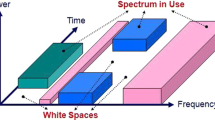Abstract
Collaborative cognitive mesh networks (CCMN) are a potential technology to be adopted in next-generation wireless networks, as it meets key requirements of 5G application scenarios, such as high flexibility and efficient spectrum usage. CCMN is composed of regular cognitive mechanisms and components, such as energy detection-based sensing, and has the ability to switch the data channel to take advantage of any available channels on a given spectrum band. Several cognitive mesh network architectures employ a common control channel (CCC) to perform dynamic channel allocation. Therefore, the multichannel–single interface manager (MC-SIM) algorithm aims to maximize channel usage with a system that does not depend on any CCC. The MC-SIM algorithm was tested in a real scenario and results showed enhanced throughput levels that are 29.5% greater.
Access this chapter
Tax calculation will be finalised at checkout
Purchases are for personal use only
Similar content being viewed by others
References
Noh J-H, Oh S-J (2011) System-level simulation of LTE/LTE-A for IMT-advanced systems. In: Vehicular technology conference (VTC Spring), 2011 IEEE 73rd, Yokohama, pp 1–5
Hossain E, Rasti M, Tabassum H, Abdelnasser A (2014) Evolution toward 5G multi-tier cellular wireless networks: an interference management perspective. In: IEEE_M_WC, vol 21, no 3, pp 118–127, June 2014
Ericsson (2014) Connected devices. [Online]. More than 50 Billion connected devices (white paper)
Gohil A, Modi H, Patel SK (2013) 5G technology of mobile communication: a survey. In: 2013 international conference on intelligent systems and signal processing (ISSP), Gujarat, pp 288–292
Dai Y, Wu J, **n C (2013) Efficient virtual backbone construction without a common control channel in cognitive radio networks. In: INFOCOM, 2013 proceedings IEEE, Turin, April 2013, pp 1456–1464
Zhang J, Zhang Z (2011) Initial link establishment in cognitive radio networks without common control channel. In: Wireless communications and networking conference (WCNC), 2011 IEEE, Cancun, Quintana Roo, pp 150–155
Kondareddy YR, Agrawal P, Sivalingam K (2008) Cognitive radio network setup without a common control channel. In: Military communications conference, 2008. MILCOM 2008. IEEE, San Diego, CA, pp 1–6
Gokhale D, Sen S, Chebrolu K, Raman B (2008) On the feasibility of the link abstraction in (rural) mesh networks. In: INFOCOM 2008. The 27th conference on computer communications. IEEE, Phoenix, AZ, pp 13–18
Kyasanur P, Chereddi C, Vaidya NH (2006) Net-x: system extensions for supporting multiple channels, multiple interfaces, and other interface capabilities, Technical 2006
Carrillo D, Mathilde F, Yoshimura R, Bazzo J (2013) Red experimental cognitiva: Algoritmos y resultados. In: 2013 IEEE Colombian conference on communications and computing (COLCOM), Medellin, pp 1–5
Subramanian AP, Buddhikot MM, Miller S (2006) Interference aware routing in multi-radio wireless mesh networks. In: 2nd IEEE workshop on wireless mesh networks, 2006. WiMesh 2006. Reston, VA, pp 55–63
Waharte S, Ishibashi B, Boutaba R, Meddour D (2008) Interference-aware routing metric for improved load balancing in wireless mesh networks. In: IEEE international conference on communications, 2008. ICC ‘08. Bei**g, pp 2979–2983
Aguayo D, Bicket J, Morris R, De Couto DSJ (2003) A high-throughput path metric for multi-hop wireless routing
Draves R, Padhye J, Zill B (2004) Comparison of routing metrics for static multi-hop wireless networks, Technical 2004
Kassler AJ, Di Felice M, Gerla M, Kim W (2010) Cognitive multi-radio mesh networks on ISM bands: a cross-layer architecture. In: Performance computing and communications conference (IPCCC), 2010 IEEE 29th international, Alburqueque, NM, pp 34–41
Kyasanur P, Vaidya NH (2006) Routing and link-layer protocols for multi-channel multi-interface ad hoc wireless networks. In: ACM SIGMOBILE mobile computing and communications review, New York, pp 31–43
Draves R, Padhye J, Zill B (2004) Comparison of routing metrics for static multi-hop wireless networks. In: ACM SIGCOMM computer communication review. New York, pp 133–144
Raniwala A, Gopalan K, Chiueh T (2004) Centralized channel assignment and routing algorithms for multi-channel wireless mesh networks. In: ACM SIGMOBILE mobile computing and communications review, vol 8, no 2, pp 50–65, April 2004
Dunagan JD, Bahl P, Chandra R (2008) Slotted seeded channel hop** for capacity improvement in wireless networks, US Patent 7,379,447
So J, Vaidya NH (2004) Multi-channel mac for ad hoc networks: handling multi-channel hidden terminals using a single transceiver. In: MobiHoc ‘04 proceedings of the 5th ACM international symposium on Mobile ad hoc networking and computing, New York, pp 222–233
Wu S-L, Lin C-Y, Tseng Y-C, Sheu J-P (2000) A new multi-channel MAC protocol with on-demand channel assignment for multi-hop mobile ad hoc networks. In: International symposium on parallel architectures, algorithms and networks, 2000. I-SPAN 2000. Proceedings. Dallas, TX, pp 232–237
Bian K, Park J-M (2013) Maximizing rendezvous diversity in rendezvous protocols for decentralized cognitive radio networks. IEEE Trans Mobile Comput 12(7):1294–1307
Chandran A, Karthik RA, Kumar A, Naidu RC, Siva MS, Iyer US, Ramanathan R (2010) Evaluation of energy detector based spectrum sensing for OFDM based cognitive radio. In: 2010 international conference on communication and computational intelligence (INCOCCI), Erode, pp 163–167
Hart J, Fu Q, **a D (2013) Evaluation of the Minstrel rate adaptation algorithm in IEEE 802.11g WLANs. In: 2013 IEEE international conference on communications (ICC), Budapest, pp 2223–2228
Author information
Authors and Affiliations
Corresponding author
Editor information
Editors and Affiliations
Rights and permissions
Copyright information
© 2017 Springer International Publishing AG
About this chapter
Cite this chapter
Carrillo, D., Takaki, R., Lira Figueiredo, F., Mathilde, F. (2017). 5G Cognitive Wireless Mesh Network Without Common Control Channel. In: Paradisi, A., Godoy Souza Mello, A., Lira Figueiredo, F., Carvalho Figueiredo, R. (eds) Cognitive Technologies. Telecommunications and Information Technology. Springer, Cham. https://doi.org/10.1007/978-3-319-53753-5_6
Download citation
DOI: https://doi.org/10.1007/978-3-319-53753-5_6
Published:
Publisher Name: Springer, Cham
Print ISBN: 978-3-319-53752-8
Online ISBN: 978-3-319-53753-5
eBook Packages: EngineeringEngineering (R0)




